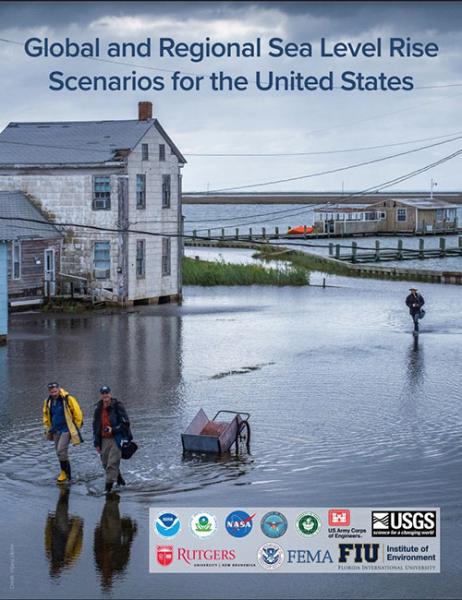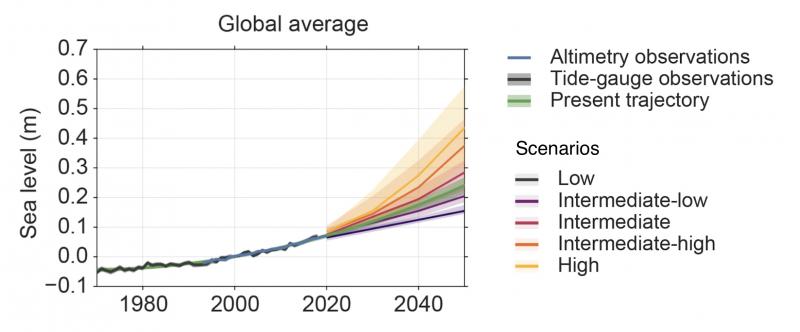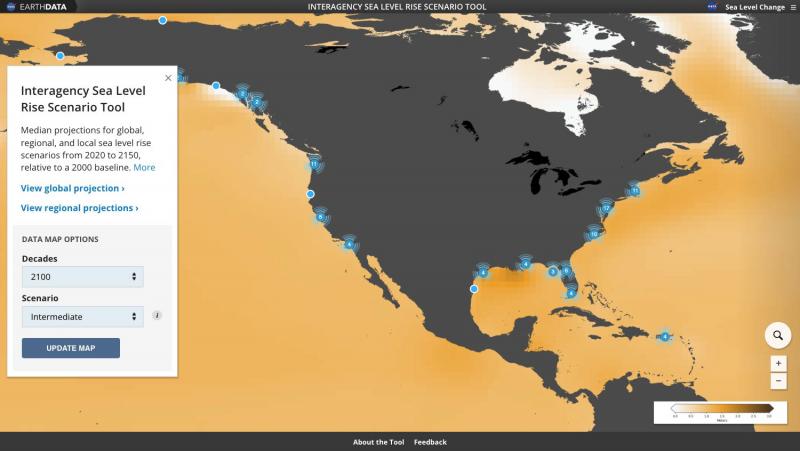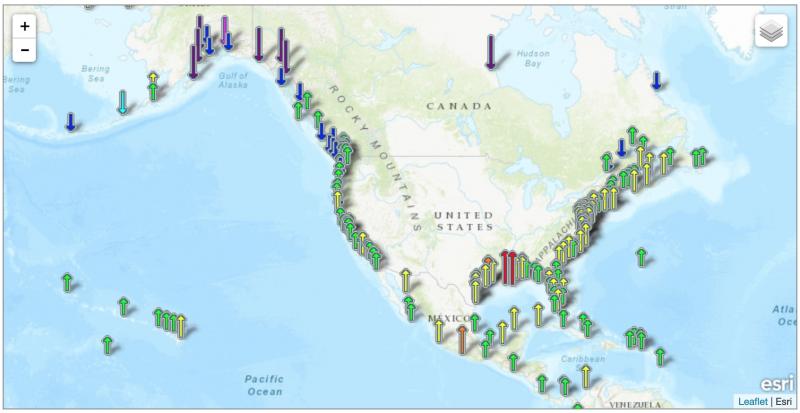Sea Level Rise
At the global scale, sea level is rising. Measured at tide gauges on every continent and by satellites on orbit, global average sea level has risen about 10-12 inches over the last 100 years (1920-2020)1.
The observed increase in global average sea level is due mainly to melting of glaciers and ice sheets on land and the thermal expansion of ocean water as it warms. In regions where land is rising faster than sea level, due to tectonic forces, for instance, as in southeast Alaska, local sea level change is decreasing. In other regions, where land is subsiding as a result of pumping water or oil from underground, local sea level is increasing faster than the global average.
Global sea level rise scenarios
2022 Sea Level Rise Technical Report
Released in Februrary 2022, Global and Regional Sea Level Rise Scenarios for the United States, also known as the 2022 Sea Level Rise Technical Report, provides the most up-to-date sea level rise projections available for U.S. states and territories.
The report is a multi-agency effort, representing the first update since a similar report in 20172. The report provides projections for every decade to 2050, and then every 50 years out to the year 2150. The report also includes information to help communities assess potential changes in average tide heights and height-specific threshold frequencies as they strive to adapt to sea level rise.
Access the online version of the report » or Download a PDF of the entire report »
Human-caused climate change has made a substantial contribution to global mean sea level rise since 1900, contributing to a rate of rise that is greater than during any preceding century in at least 2,800 years.2 Sea level along the U.S. coastline is projected to rise, on average, 10-12 inches (0.25-0.30 meters) in the next 30 years (2020-2050). This is on top of the 10-12 inches of rise that occurred over the past 100 years (1920-2020). Sea level rise will vary regionally along U.S. coasts because of changes in both land and ocean height.1
Sea Level Rise through 2050
In the report released in 2022, oceanographers and climatologists present observation-based extrapolations (“trajectories” of current sea level rise) and projections for a set of five global sea level rise scenarios. Each scenario is based on a different assumption about the degree to which ocean warming and ice sheet melting will affect the rate and amount of global sea level rise. Choices the world makes about emissions will also influence sea level.
To accompany the 2022 Sea Level Rise Techical Report, NASA produced the Interagency Sea Level Rise Scenario Tool. Use it to explore maps or graphs showing projections for global, regional, and local sea level rise scenarios along the coasts of U.S. States and Territories. Median projections, relative to a 2000 baseline are available for every decade from 2020 to 2150 for each of the five scenarios.
Learn more about the scenarios »
Regional and local sea level changes
At the regional scale, sea level is also influenced by ocean currents, wind patterns, and meltwater from glaciers and ice sheets on Greenland and Antarctica. On smaller scales, environmental factors such as shifts in ocean circulation patterns, changes in Earth's gravitational field and rotation, vertical land movements, sediment compaction, groundwater and fossil fuel withdrawals, and other non-climatic factors can influence the direction, rate, and magnitude of local sea level changes.
In the next three decades, the following amounts of sea level rise are anticipated for these U.S. regions:
| U.S. Region | Anticipated Sea Level Rise by 2050 |
|---|---|
| East Coast | 10 - 14 inches (0.25 - 0.35 meters) |
| Gulf Coast | 14 - 18 inches (0.35 - 0.45 meters) |
| West Coast | 4 - 8 inches (0.1 - 0.2 meters) |
| Caribbean | 8 - 10 inches (0.2 - 0.25 meters) |
| Hawaiian Islands | 6 - 8 inches (0.15 - 0.2 meters) |
| Alaska's North Coast | 8 - 10 inches (0.2 - 0.25 meters) |
For graphs, charts, and maps of sea level rise projections for specific regions of the United States through 2050, see pages 18-20 of the full 2022 Sea Level Rise Technical Report (PDF).
Longer-term Sea Level Rise
Beyond 2050, sea level is expected to continue rising as more land-based ice melts and water continues to expand as it warms. Table 2.3 from the 2022 Sea Level Rise Technical Report shows projections for each scenario for the global average and for the contiguous United States in 2050, 2100, and 2150.
Other tools for checking your local Sea Level Rise:
NOAA's Sea Level Rise Viewer provides visualizations of areas expected to be inundated at high tide after various amounts of sea level rise. The viewer also offers a Local Scenarios tab that gives users the option to select 2017 or 2022 scenarios for visualizing changes. Users can also check the rate of regional sea level change via the U.S. Army Corps of Engineers' Sea Level Change Curve Calculator.
Using risk tolerance as a method for choosing a sea level rise scenario
Calculating the number of years a project is likely to be useful before being impacted by flooding or inundation can help decision-makers select a scenario based on their tolerance for risk.
For projects involving structures that are expected to have a long lifetime, where a loss would be catastrophic, or where there is limited flexibility for adaptation, people want to minimize risk, so focusing on the higher scenario projections may be appropriate. Examples of these low-risk-tolerance projects include power plants, shipping ports, hospitals, and refuges for endangered species.
Where projects are expected to have a short life span, require little infrastructure, or have the flexibility to make alternate choices, the tolerance for risk is often relatively higher, so projections for lower scenarios may be appropriate. Examples of projects that fall into this category include bike paths, golf courses, and parks.
- 1a1bSweet, W.V., B.D. Hamlington, R.E. Kopp, C.P. Weaver, P.L. Barnard, D. Bekaert, W. Brooks, M. Craghan, G. Dusek, T. Frederikse, G. Garner, A.S. Genz, J.P. Krasting, E. Larour, D. Marcy, J.J. Marra, J. Obeysekera, M. Osler, M. Pendleton, D. Roman, L. Schmied, W. Veatch, K.D. White, and C. Zuzak, 2022: Global and Regional Sea Level Rise Scenarios for the United States: Updated Mean Projections and Extreme Water Level Probabilities Along U.S. Coastlines. NOAA Technical Report NOS 01. National Oceanic and Atmospheric Administration, National Ocean Service, Silver Spring, MD, 111 pp.
- 2a2bSweet, W.V., R. Horton, R.E. Kopp, A.N. LeGrande, and A. Romanou, 2017: Sea level rise. In: Climate Science Special Report: Fourth National Climate Assessment, Volume I [Wuebbles, D.J., D.W. Fahey, K.A. Hibbard, D.J. Dokken, B.C. Stewart, and T.K. Maycock (eds.)]. U.S. Global Change Research Program, Washington, DC, USA, pp. 333-363, doi: 10.7930/J0VM49F2.





